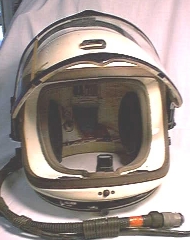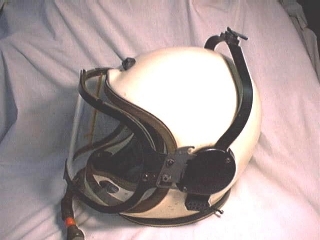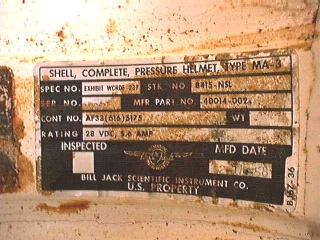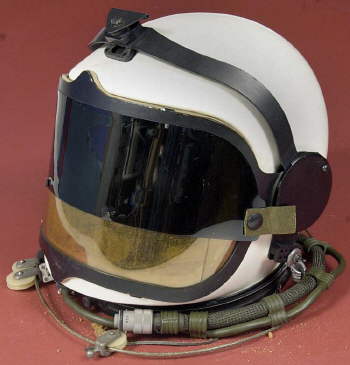US pressure gear
Message 3623, Jul 28, 2001
Hi John, This is a somewhat complicated subject you reference, as I shall explain. The
MC-4 and MC-4A suits were the last expression of the so-called mechanical (or capstan)
partial pressure suit developed by the Air Force until the TLSS program developed new
avenues of inquiry in the mid 80s.
In the period from about 1946 through 1948 the David Clark Company produced versions of
Dr. Henry's original mechanical (capstan) partial pressure suit (prototype developed in
about 1946) in custom sizes for flight test pilots such as Yeager, et al.
In about 1948, the David Clark Company produced the T-1 suit (the first 'operational'
partial pressure suit) for flight test and high altitude fighter test operations pilots in
12 standard sizes. By 1953 this suit was in use by fighter pilots in routine high altitude
fighter operational missions.
The T-1 suit, one of the very first production capstan suits, used a 5-to-1 pressure
constricting ratio, had no chest bladder, included both a pressure garment and an anti-G
function, and was intended purely as a "get-me-down" emergency decompression
suit. It provided about 6 to 8 minutes of protection only, at an altitude of about 65,000
feet. Interestingly, the T-1 suit was tested in hypobaric chambers to simulated altitudes
of about 106,000 feet, where it safely provided the emergency pressurisation needed for a
quick descent to lower altitudes.
The S-2 suit, evolved from the T-1 suit in the 1953-54 period, was similar to the T-1, but
lacked the anti-G system, had no chest bladder, and was intended principally for used by
bomber (SAC) crews who did not need protection against the forces encountered in ACM type
flight (but who also needed the emergency decompression protection afforded by the T-1).
12 standard sizes for bomber aircrew were produced. Historical records state that the S-2
suit was used routinely with the K-1 partial pressure helmet assembly.
The S-4 suit (1955) was a modified S-2 suit that incorporated no chest bladder or anti-G
system, but featured an abdominal bladder (specifically for use by individuals who had
weak inguinal rings). It was also used alternately by bomber crews, with the S-2.
The MC-1 series suits (next along the development trail and introduced about 1956) was a
modified S-2 suit that added breathing bladders to chest and abdominal torso sections of
the suit to reduce the work of breathing and that also featured smaller arm & shoulder
capstan systems; it was the first capstan suit designed specifically to permit somewhat
extended flight at higher altitudes and was produced in 12 standard sizes for both fighter
and bomber crews. The MC-1 suit included specially designed pressure gloves, as well as
what were termed "anti-pinch" bladders beneath the capstans (to reduce friction
and prevent skin abrasion). Historical documentation again specifies that the MC-1 type
suits were used with "either the K-1 or MB-5 helmets".
The MC-3 (1957) and MC-4 (1958) suits were designed to provide extended high altitude
operation, and both included a full-torso bladder to reduce effort of breathing at
altitude. The MC-3 had a horizontal shoulder zipper, sewn breaklines, no anti-G system,
used height/weight sizing criteria, and was utilised in bomber and recon aircraft; it was
also manufactured, in 12 standardised sizes, by David Clark Company. It is noted in
documents that this suit was principally used with the MA-2 helmet assembly, for which the
primary system contractor was ILC of Dover.
In 1958 the MC-3A was introduced, which was a modified MC-3 with vertical shoulder lacing
and adjustable break lines. David Clark and Berger Brothers were the primary contracting
manufacturers. The MA-2 helmet (ILC) was specified for use with the MC-3A partial pressure
suit.
In late 1958/early 1959 the MC-4 capstan partial pressure suit was introduced, which
featured vertical lacing, adjustable break lines, an anti-G bladder system. It was used
with the MG-1 pressure gloves and MA-2 helmet assembly (ILC). Shortly thereafter, the
final refinement, known as the MC-4A partial pressure capstan suit was introduced
(principally for fighter operations use) and remained in use until about 1964. This suit
was a modified MC-4 suit, incorporating height/weight fitment criteria for fighter cockpit
requirements, and an anti-G suit assembly. It is specified in historical documentation
again that the MC-3 and MC-4 series suits were used with both the MA-2 and MB-5 helmets,
as well as with the MA-3 (Bill Jack) helmet. (Use of the MC-3 series and MC-4 series suits
continued in operational use until about 1964, as noted above).
The early K-1 helmet (the so-called "split-shell" K-1) was used with both the
T-1 and initially with the early S-2 suit. Later, the K-1 helmet was improved with the
addition of a one-piece fiberglass shell that had anti-lift helmet constraint cable
attachments externally located, bilaterally, on the helmet shell. The final K-1 shell had
these attachment points moved internally, to the inner, lower rim of the improved
one-piece green K-1 shell on both sides. The improved (single external fiberglass shell)
K-1 was used most frequently with the later S-2 production suits.
Whereas the K-1 series helmets were used with the early suits (the T-1, S-2, and MC-1
suits), the MC-3 and MC-4 series suits used the newer, improved helmet designated the MA-2
assembly, for the most part, although it is noted that they were also used with the MB-5
helmet. The MA-2 external fiberglass shell was of one-piece construction (like the last
K-1 shell), but was painted white. The MB-5 helmet assembly was quite similar to the K-1
helmet and was used mainly by SAC crews with the S-2, MC-1, and MC-3/MC-4 suits. By 1959
records indicate that the standard USAF capstan pressure suits in use were the MC-3 and
MC-4 series suits, routinely used with the MA-2 helmet assembly and MB-5 helmet
assemblies.
Among the distinctive differences notable between the T-1, S-2, and later suits were
variant lacing patterns, necessitated by the functional intent and design parameters of
the suits (i.e. pressure suit or pressure suit and anti-G system combinations). All of the
mechanical or capstan partial pressure suits were uncomfortable, due to the fact that they
had to be snug fitting even in the normal unpressurised mode. They were also warm and were
usually worn over light cotton inner underwear. Further, they were intended as an
undergarment to be worn beneath the external flight suit and any other outer protective
clothing, such as anti-exposure suits. A special inner ventilation garment could be also
be worn. A major departure from the capstan type partial pressure suit was the
introduction of bladder type partial pressure suits in the early to mid-60s, such as the
CSU-4/P series. These suits did not use capstan systems to achieve high-altitude
protection. The principle in use in the CSU-4/P type garment was due to be further
developed in coming years into such systems as the TLSS project equipment. Successful
experience with the CSU-4/P concept also resulted in the David Clark suits used in the
Space Shuttle protective "Launch-Entry" suits, initially introduced in about
1987, which employed bladder type compression of the CSU-4/P principle in combination with
a full-pressure helmet and an integrated anti-exposure overassembly to provide protection.
Today capstan or mechanical type partial pressure suits are no longer used actively by the
US Air Force, although suits of this specific type are still in use by various foreign
nations (examples are the former "Warsaw Pact Powers" and the People's Republic
of China). They bear startling resemblance to the USAF capstan partial pressure suits of
the 50s and early 60s (and were most likely copied directly from the American design).
This is all general background information that may be helpful, for your purposes, to be
aware of.
Coincidentally, after the late 1950s, SAC crews were no longer routinely required to wear
partial pressure suits on operational missions due to the fact that low-altitude nuclear
penetration was by that time the mandated nuclear mission profile, necessitated by the
deployment of improved anti-aircraft missile systems throughout the Warsaw Pact nations
that could easily strike down high flying bombers. Fighter pilots continued to wear the
capstan partial pressure suits into the early 60s and for special missions (U-2 &
TR-1), although gradually the highest altitude missions (strat recon, SR-71 type) were
being by that time flown with the newer full pressure suits that had come into production
in the early 60s. In view of the above historical documentation references, your MB-5
helmet and MC-4 suit could have been and probably were used together as a properly matched
set and the time frame would likely have been in the late 1950s/early 60s. I hope this
information has been useful and helpful to you in your museum display project.
Cheers, DocBoink
Message 3622, Jul 27, 2001
Hi, Got a question for the group, I'm trying to assemble a representitive example of a US
partial Pressure suit for a museum display. I recently picked up a MC-4 suit, along with a
MB-5 partial pressure helmet that I'd like to use as the suit is large enough for the
manniquin I have available. I also have a K-1 along with a MC-1 suit that I know was
issued together but it's too small for the manniquin. I'm familiar with the K-1, MC-1, C-1
bottle/reg assy as a "proper" combo, but I'm having trouble finding any info on
timeframe/application on either the MC-4 suit or the MB-5 helmet. The helmet appears to be
a K-1 with a different mike and comm plug ( the short hood, earphone assy's and green
outer shell appear to be the same as a K-1, however, it has a M-55/AIC green mic with a U
93A/U plug on the comm wire and the fitting or strain relief on where the wire enters the
helmet is different than on a K-1) I'm fairly sure that the helmet and suit were flown
together as they came from a militaria dealer at a local Flea Market that had no other
aviation stuff at all, let alone flight gear. Does anyone out there know the application
of the MC-4 suit with a MB-5 helmet and about what year they would be used ? I also need
to know if the early faceplate off my K-1 would be correct or do I need the later version,
and what the proper bailout/suit pressurization bottle and reg assy is correct. I can't
find any info one either of these items in any of the sources I have, I've seen references
to the MC-4 suit, but nothing at all on the MB-5 version of the helmet. I'm assuming it
may be a SAC issued version of the K-1 but I'm not sure ( I've read that "MB"
designated gear was usually SAC issued, but I can't confirm that either) ANY help or info
on this subject would be greatly appreciated.
Thank's John (Jetstuff)
Message 3571, Jul 24, 2001
Hi Wizzo, As far as I know the replica faceplates did not include details as fine as the
actual demisting filigree, however, they certainly would fool anyone from a distance of
more than 2 feet, from what I saw of them. I haven't seen "13 Days", although
I'd like to, so I'll defer to someone who has seen it in the U-2 flightgear scene you
mentioned.
Cheers, DocBoink
Message 3570, Jul 23, 2001
Last time I checked with Dennis, that faceplate he had posted didn't sell - I contacted
him directly and he said the reserve had been $550. Lacking only the anti-fogging filament
in the lens, I considered it worth every penny - just didn't have a spare K-1 for it to go
on! If you really want it, he might still have it.
Maggot
Message 3566, Jul 23, 2001
Do the replicated faceplates have the electrical heating wire for the face shield? Another
question: In the film, 13 Days, the U-2 suiting up in the MC-4 in chapter 26, would that
be a real suit or a replica suit? To me, the lacing seemed a bit thicker than on the
artifacts in my collection.
Wizzo
Message 3565, Jul 23, 2001
Downwind28, Another point to remember: Dennis Gilliam, the pressure-suit wizard, was able
to fabricate faceplates for the K-1 and MA-2 helmets that were so authentic that they
could nearly fool an expert. So, even if a faceplate doesn't materialise, there are ways
to come up with these (rare) critical missing bits. Dennis auctioned off one of his
fabricated faceplates on eBay a few months ago and I couldn't believe how accurately the
fabricated faceplates appeared. I personally could not spot any differences between the
real article and the replica. If he could do it once, he could certainly do it again (or
show you how to do it yourself).
Good luck on the bidding. Cheers, DocBoink
Message 3564, Jul 23, 2001
Downwind28 - I wouldn't let the lack of a faceplate get in the way of bidding - the
faceplates are rarer than hen's teeth to begin with - near as I can tell, everything else
looks pretty decent on this item. If you can get it for $500 or less I would consider it a
steal.
Maggot
Message 3552, Jul 22, 2001
Hi Downwind, No the helmet has NO faceplate. See pictures attached for reference and
description.
regards, Moonbeam
US High Altitude helmet, MA-2, with intergral avionics intact. Rubber seals are intact but
getting old and dry, NO faceplate. Man's name GEO. McDaniels on both pieces. Overall
condition Good to VG. Would display well. Might be rare but I don't know anything about
flight gear





MA-2 partial pressure helmet missing its face plate.
© unknown
Message 3083, Jun 22, 2001
I for one would love to see the photographs of that suit helmet (or the suit). I vaguely
recall you mentioning this, but don't remember the image details. Sounds intriguing,
however.
Cheers, DocBoink
----- Original Message -----
June 21, 2001
> A while back, A partial pressure suit helmet showed up on E-Bay. It had an oblong
neck ring but was rather well made. I don't know if I still have pictures of this
particular helmet, but I'll look.
> When I shopped this helmet around, the USAF pressure suit folks though
this helmet was designed by Dr. Lombard for Lockheed. I haven't received
official confirmation of this and I can't seem to find anything else on Dr.
Lombard.
> I do have a 1949 patent for a flight helmet. I'll have to check the name but it was
Edwin ????. Diagram accompanying the patent loks very much like the H-1 with a bunch of
snaps embedded on the sides(s) of the shell.
> Cheers, Steve
Message 2942, Jun 16, 2001
John, Thanks very much for sharing the most fascinating photographs of the MA-3. The MA-3
has always been for me one of the most interesting of the early (late 50s) pressure suit
helmet developments. And who among us who grew up in that era could forget the
indominatable "Colonel McCauley", who was regularly wearing his in that
unforgettable, if a bit schmaltzy series. You are a luckily man indeed if your friend can
find the matching suit for this rare item. It is well worth the wait, if you ask me, but I
would be tempted to put a bit more pressure (no pun intended, but it certainly 'suits' the
subject) on him to find it.
Cheers, DocBoink
Message 2901, Jun 13, 2001
Hi to group, The second set of Jpegs is of a Bill Jack MA-3 Pressure helmet. I got this
right from the pilots son ( flew at Edwards in the late 1950's) The liner apparently
turned to the same dust as the first helmet but the rest of it is in great shape. It's
dated 2/58 and is serial # 68 The reference lines taped on the visor are kind of neat each
one is identified by a tiny letter pencilled on. The owners son keeps promising me the
matching suit if he can find it (swears it's in the attic, been waiting patiently for 3
years or so ....) I'll post some pic's of the early Toptex I have as soon as I get to
photograph it.
John





MA-3 pressure helmet. © John 'Jetstuff' Spencer
Message 2880, Jun 12, 2001
Greetings to the Heresiarch of Uqbar, I am one who may know some answers to your
questions. When "Men into Space" premiered, the spacesuit worn by Col McCauley
was a USN Mark IV with MA-2/P harness. The subsequent episodes had the crews wearing
helmets closer to the HGU-8/P, as shown in the attachment. So both Mk IV and HGU-8 types
were seen. Our illustrious DocBoink can give you fine details about these helmets and
suits used by Hollywood in their programs. Doc, could you provide the Heresiarch some
info?
Gato

MA-3 pressure helmet © Gato
Message 2879, Jun 12, 2001
To anybody could know about: I'm in trouble trying to identify the MA-2 (made by ILC
Dover) and HGU-8/P helmets, and the CSU-4/P partial pressure suit. If somebody has a good
pic of any of them, I'll be glad. Am I wrong - or one of both hats was the costume issue
often shown in some old scifi TV series like MEN INTO SPACE or THE OUTER LIMITS? Otherwise
- how could be distinguished between pictures of an old Shuttle Launch/Entry Suit (LES)
and the new Advanced Crew Escape Suit (ACES)?
Yours truly, The Rememberful Heresiarch of Uqbar
Message 2430, May 22, 2001
Downwind28, The Project Mercury suit was in fact a specially modified US Navy Mk.IV suit
and helmet that was built up specifically for the first orbital flights. It was known in
NASA as the "Quick Fix" suit. There is a bit of history dealing with this to be
found at my website, in my web article titled "A History of US High Altitude Pressure
Suits". You can dial up the URL and read this history for yourself. Give it some time
to download as it is a large file, with illustrations of the various suits.
Another excellent source (perhaps one of the best possible) for information about the
relationship between the US Navy Mk.IV suit and NASA developments is NASM historian
Lillian Kozloski's book on this subject, entitled US SPACE GEAR: OUTFITTING THE ASTRONAUT
(Smithsonian Institution Press, Washington, 1994, ISBN 0-87474-459-8). As you will see,
the US Navy Mk.IV suit was truly the forebear of just about everything that followed,
either in the atmosphere or in space.
Cheers, DocBoink
Message 2428, May 22, 2001
Downwind28, The USN Mk.IV was typically used in such 'spacious' aircraft as the F-4
Phantom II, the F8U Crusader, and similar types that had large enough crew spaces to allow
use of the full pressure suit. It could be worn also in the A3J and RA-5 (Vigilante), but
the A-4 Skyhawk ("Heinemann's hotrod") was just too cramped and confining to
allow for comfortable use of such a bulky system.
I did not check the specific eBay item you referenced, but I do recall that a Mk.III was
recently misidentified as a Mk.IV, so this may in fact be the one you refer to.
Misidentification of Mk.III and Mk.IV helmets isn't that unusual among those who have less
specific understanding of the differences between the two. You were therefore probably
correct in your identification.
Cheers, DocBoink
Message 2419, May 21, 2001
Thanks for your quick response! What intrigues me is that the Mk IV is very close to the
Mercury helmets - as close to an astronaut helmet one can possibly get without being a
millionaire.
Downwind28
Message 2416, May 21, 2001
Hi Downwind28, Welcome to the group. The helmet you saw on ebay appeared to be an early
Mark IV or a Mark III. The large neck ring and the shape of the visor, plus the old style
regulator depict this. TAPKY (Ricardo ) on the group has a nice Mk IV helmet for sale.
Gato
Message 2412, May 21, 2001
To all: I am trying to educate myself a bit on MK-IV equipment. In a recent sale of a
helmet described as a "MK-IV" on ebay (1141744831) I wrote to the seller that
the piece looked more like a MK-III to me - but I never got a response. Was I right? In
which aircraft was the MK-IV helmet typically used during the early sixties?
Regards, Downwind28
Message 1126:
Hello Ricardo and Christo, I believe Ricardo is correct: the visor units in reference
(those on eBay at this time) are visor units intended to replace those on the USAF HGU-8/P
and HGK-13/P type pressure helmets, although they do bear resemblance to those on the USN
Mk.III & Mk.IV helmets. Keep in mind that the USAF A/P22S-3 pressure suit assembly
derived directly from US Navy Mk.series pressure suit developments, hence the 'family
associations'. Cheers, DocBoink
Message 1125:
Hi, these visors are made for replace the original HGU-8 shields. They doesn't fit Mk-IV
easily, need some adjustment and a lot of work. Steve Frittz have a lot of experience
about this matter. He have restored one Mk-IV with this type of visors. No, they don't fit
Mk-III. Forget it !! ;-) Cheers Ricardo, Spain
> Christo Leventis wrote: Hi all, Does anyone know what type of helmets these visors
fit?
>There have been a few on ebay recently. They look to me like Goodrich Mk III/IV.
>Anyone with better info? Christo.
 Message 726:
Message 726:
Wizzo, I am well aware of that photograph you mention, showing the pilot wearing the MC-3A
pp suit with an HGU-8 pressure helmet assembly (see attached photo image from the book
"Black Magic"), although I seem to recall that it was explained that this was a
rarely used combination that was mostly utilised in the TR-1 and earlier U-2 aircraft, due
to restricted cockpit dimensions that wouldn't accomodate the bulkier A/P22S-2 and 3
assemblies (and definitely not the later S-901, S-1010, etc. gear). The look-alike HGK-13
was used with the A/P22S-2 fps assembly, of course, in the larger and roomier early model
A-11, YF-12A, and SR-71s aircraft until replaced by the S-901, S-1010, and subsequent
assemblies (etc.). However, I found that photograph quite interesting myself and inquired
of a former Dragonlady pilot about it. He reiterated (confirmed) the lack of cockpit room
in the early (original) U-2 models, specific to the above question. I would imagine that
Steve Fritts could shed some light on this, working as he did with the TR-1 and U-2
aircraft ops. Cheers, Chris.
Message 498:
Steve: The USN used the C1-AM partial pressure suit in the late 1950's/early 1960's, I'm
sure among others. Craig Hall
Message 494:
Steve: My research has revealed that the Goodrich MK IV suit was used in the F-8 Crusader,
the F-4 Phantom II, and the A-3/A-5/RA-5C Vigilante. Anyone know of any others? Craig Hall










 Message 726:
Message 726: